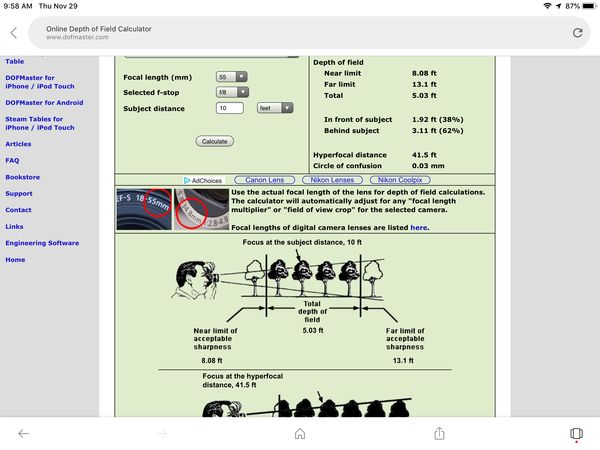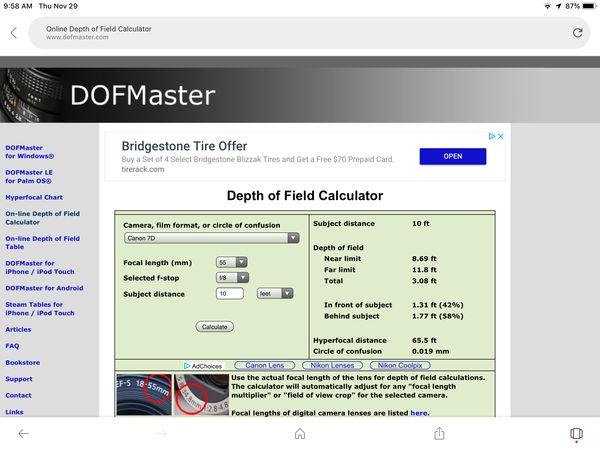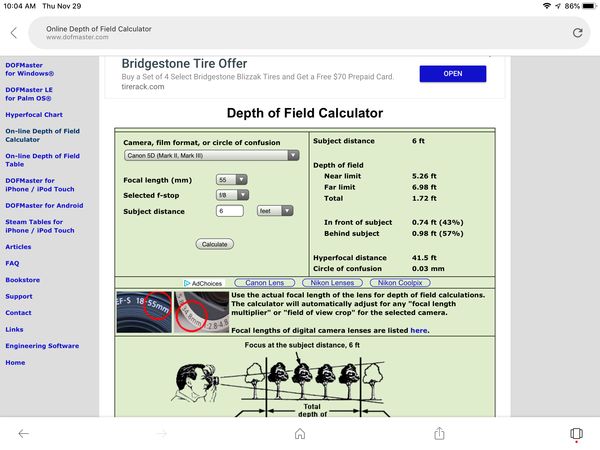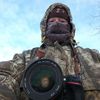Size matters
Nov 29, 2018 09:05:29 #
Nov 29, 2018 09:14:05 #
Actually the smaller the format the larger the depth of field not the other way around.
Nov 29, 2018 09:20:17 #
Size of sensor matters, but not so much that I would give up an all-around camera to get it.
As far as the current quality of landscape photography declining, I disagree. One of the links I would use to show examples of current amateurs producing great results with normal cameras:
https://www.uglyhedgehog.com/s-5-1.html
As far as the current quality of landscape photography declining, I disagree. One of the links I would use to show examples of current amateurs producing great results with normal cameras:
https://www.uglyhedgehog.com/s-5-1.html
Nov 29, 2018 10:07:03 #
DaveC1 wrote:
Actually the smaller the format the larger the depth of field not the other way around.
Depends on whether we mean for same subject distance or same FOV.
Courtesy DOFMaster: for the same subject distance and aperture, larger format = greater DOF. Now if you, move closer with the FF to get the same field of view as the crop, then the result changes.
Canon 5D3 (Full Frame)

Canon 7D (crop)

5D3 at 6 ft (~same FOV as crop at @10’)

Nov 29, 2018 10:24:31 #
rook2c4 wrote:
Surely you must be joking. Those are horrible examples of landscape photography. Everything drowned in candy colors. Nothing looks real. That's fantasy photography, not landscape photography.
Looks good to me. You see what we have here is a failure to understand you have personal tastes that differ from others and vice versa.
Those examples are not horrible and the man is probably making a living doing so. It is Fine Art landscape photography.
As for the OP I say prove it or show us examples and many here can show you just as good examples. Comparing large format to digital is like comparing apples and oranges anyway.
Nov 29, 2018 10:29:21 #
Nov 29, 2018 10:31:52 #
AlfredU wrote:
Wow, "And we kind of got off the topic of size matters. I thought the OP made an interesting and somewhat thought provoking comparison. Again, my opinion.
He did conclude in the final comment landscape photography has gotten worse so I believe the other posts are on topic.
Nov 29, 2018 10:35:36 #
TriX wrote:
Depends on whether we mean for same subject distance or same FOV.
Courtesy DOFMaster: for the same subject distance and aperture, larger format = greater DOF. Now if you, move closer with the FF to get the same field of view as the crop, then the result changes.
Courtesy DOFMaster: for the same subject distance and aperture, larger format = greater DOF. Now if you, move closer with the FF to get the same field of view as the crop, then the result changes.
What your neglecting here is that the focal length of the lens and the format "Play together" in the overall picture. For instance a 25mm lens in a 4/3 format is roughly equivalent to a 50 mm lens in 35mm or ff. And that is roughly equivalent to a 75mm lens in 6X6cm. Once you take those differences into account the smaller the format the greater the DOF for an equivalent image. You can't hold the lens focal length constant and get comparable images when moving between formats.
Nov 29, 2018 10:41:14 #
nadelewitz
Loc: Ithaca NY
Bipod wrote:
Smaller format: br Pros-- br * Faster lenses (for ... (show quote)
Is there a point or conclusion to be found here?
Nov 29, 2018 11:05:52 #
DaveC1 wrote:
What your neglecting here is that the focal length of the lens and the format "Play together" in the overall picture. For instance a 25mm lens in a 4/3 format is roughly equivalent to a 50 mm lens in 35mm or ff. And that is roughly equivalent to a 75mm lens in 6X6cm. Once you take those differences into account the smaller the format the greater the DOF for an equivalent image. You can't hold the lens focal length constant and get comparable images when moving between formats.
Sorry no, I’m not neglecting anything. Note that I pointed out that it depends on whether we’re discussing equal distance or equal FOV (which is determined by distance, FL and format). Just pointing out that one needs to define the terms rather than make a blanket statement as to DOF vs format. I could have changed the lens from 50mm (crop) to 80mm (FF), but chose to change the subject distance for purposes of illustration.
Nov 29, 2018 11:35:43 #
TriX wrote:
Sorry no, I’m not neglecting anything. Note that I pointed out that it depends on whether we’re discussing equal distance or equal FOV (which is determined by distance, FL and format). Just pointing out that one needs to define the terms rather than make a blanket statement as to DOF vs format. I could have changed the lens from 50mm (crop) to 80mm (FF), but chose to change the subject distance for purposes of illustration.
So just to summarize here for an equivalent image the larger the format the smaller the DOF. Which is the only logical way to compare formats without getting into the weeds.
Nov 29, 2018 11:51:36 #
rook2c4 wrote:
Surely you must be joking. Those are horrible examples of landscape photography. Everything drowned in candy colors. Nothing looks real. That's fantasy photography, not landscape photography.
He is one of the more popular photographers around, so I’d say that I was very serious.
Here is another site - https://www.photocascadia.com These guys are the top guns today.
I respect your opinion, you don’t have to like the work and I understand that most people go out midday to shoot and never see some of the colors one would see at sunset or around sunrise.
So I welcome you to prove me wrong, instead of just calling the example horrible.
Btw, how much do you dislike B&W photography? And lastly, do you personally have any examples from any of his locations? What do your colors look like and how well do they sell?
Nov 29, 2018 11:58:54 #
GeneC123us
Loc: Sugar Land, TX
My first boss once said - "It's a poor worknan who blames his tools".
Nov 29, 2018 12:01:31 #
GeneC123us wrote:
My first boss once said - "It's a poor worknan who blames his tools".



Nov 29, 2018 12:58:16 #
If you want to reply, then register here. Registration is free and your account is created instantly, so you can post right away.



